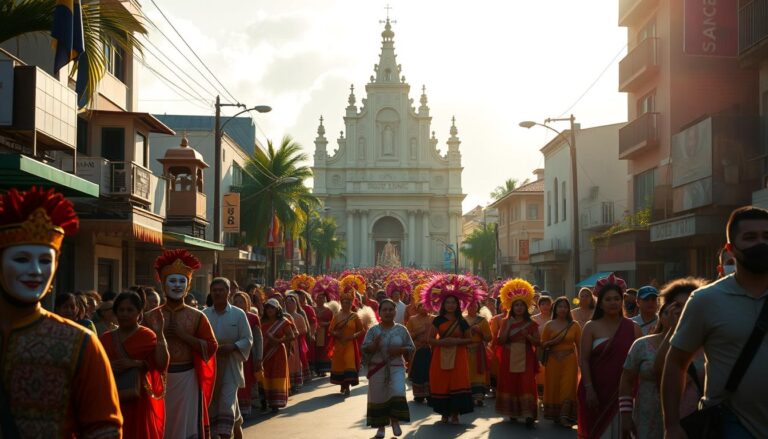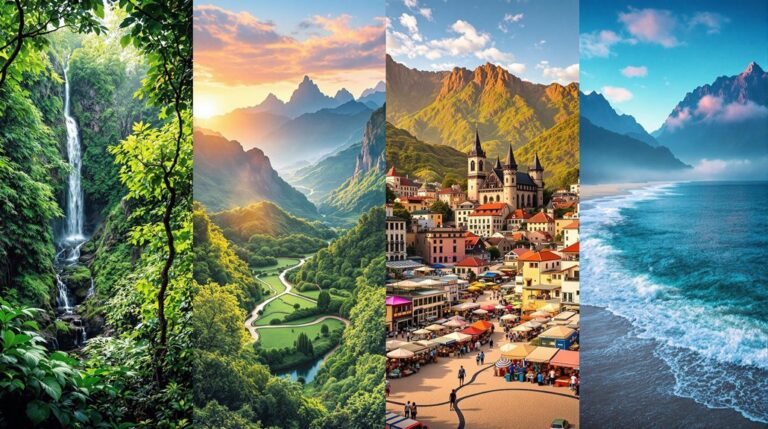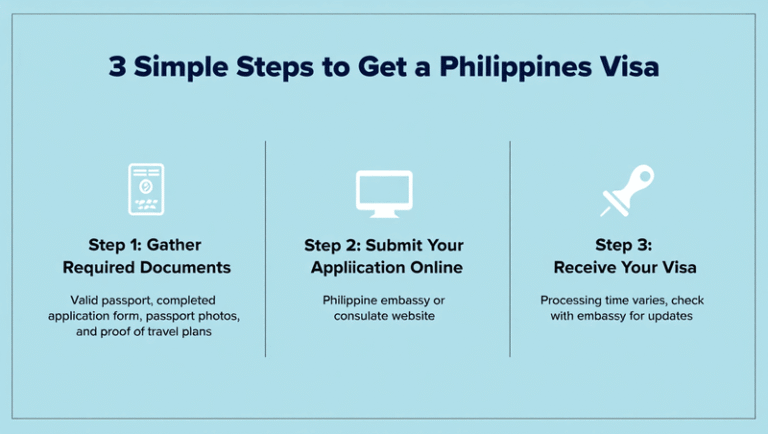US to Philippines: Direct Flights and Travel Routes
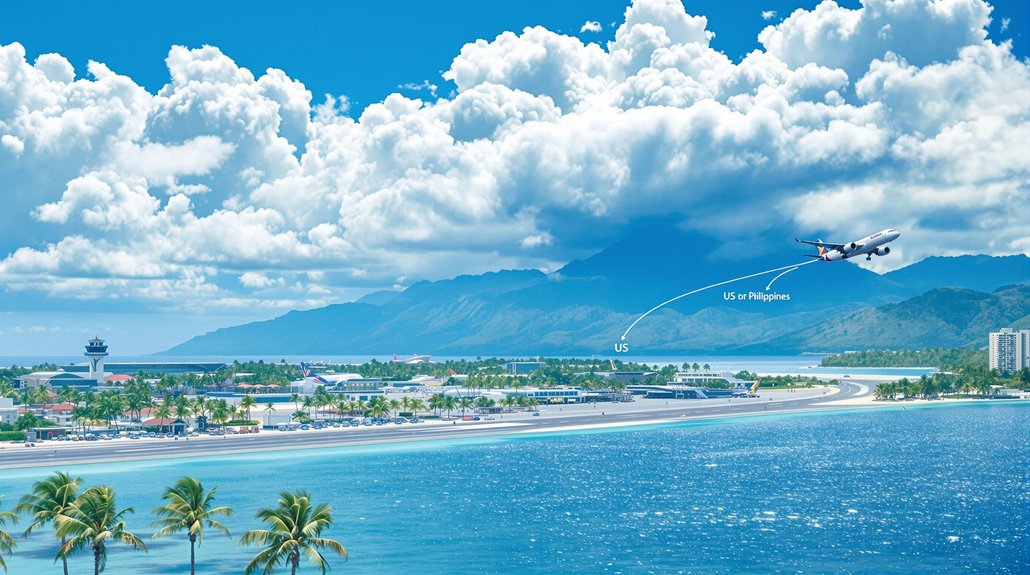
The view of the Philippines from an airplane reveals 7,641 islands spread across blue waters. Each island offers unique experiences, from white beaches in Boracay to ancient rice terraces in Banaue and busy streets in Manila. Good planning turns a simple trip into a memorable experience.
The islands present countless opportunities for adventure and relaxation. Visitors can swim with whale sharks in Oslob, explore underground rivers in Palawan, or climb the volcanic peaks near Legazpi. Many travelers find themselves returning multiple times to experience more of what the Philippines offers.
Proper preparation makes all the difference in your travel experience. This guide provides practical information about flights, destinations, costs, and timing to help you plan an excellent trip to this Pacific archipelago.
Highlights
- Philippine Airlines provides direct flights from New York, San Francisco, Los Angeles, and Honolulu to Manila. Non-stop routes offer different travel times, with flights from LAX to Manila taking about 15 hours. United Airlines now offers daily San Francisco to Manila service, launched in October 2023 using Boeing 777-300ER aircraft.
- Ticket costs range from $701 to more than $1,600 based on season and booking time. Planning helps save money. Over 46 airlines offer connecting routes, with common stops in Hong Kong, Seoul, Singapore, and Tokyo.
- These flights create important connections for people and businesses between the U.S. and the Philippines. Knowing your options helps you select the best route for your needs.
- The increased flight options reflect growing tourism and business interests between the two countries. More Americans visit the Philippines each year for both leisure and business opportunities. Filipino-Americans also benefit from these routes when visiting family and friends in the Philippines.
Airlines Providing Direct Connections
For direct flights from the U.S. to the Philippines, Philippine Airlines serves as your main choice, with United Airlines also offering service.
- Philippine Airlines offers non-stop flights to Manila from New York, San Francisco, Los Angeles, and Honolulu. These direct flights save time by eliminating layovers.
- United Airlines started daily flights between San Francisco and Manila on October 29, 2023, using their Boeing 777-300ER aircraft. This gives travelers another option for direct travel.
- Both airlines maintain high safety standards. Their loyalty programs reward frequent travelers.
With multiple weekly flights, especially during busy periods, trip planning becomes simple. These direct routes provide quick access to the Philippines.
The aircraft used for these long-haul flights typically feature modern amenities to enhance passenger comfort during the extended journey. Philippine Airlines utilizes Airbus A350-900s and Boeing 777-300ERs, while United Airlines employs their Boeing 777-300ER fleet. These planes include improved cabin pressure systems, larger windows, and better humidity controls that reduce jet lag and travel fatigue.
Economy class typically includes personal entertainment systems, USB charging ports, and improved seat cushions for the long flight. Business class offers lie-flat seats, premium dining options, and enhanced service, which might justify the higher cost for those seeking maximum comfort on such a long journey.
Key Departure Airports
Several US airports offer direct flights to Manila for travelers heading to the Philippines. Los Angeles (LAX), San Francisco (SFO), JFK in New York, and Honolulu (HNL) serve as the main hubs. Seattle (SEA) has also begun offering direct flights to Manila through Philippine Airlines.
These airports provide non-stop flights with various durations and prices to match your preferences.
The international terminals at these airports feature numerous amenities for long-haul travelers. LAX’s Tom Bradley International Terminal offers upscale dining options, duty-free shopping, and premium lounges. SFO provides a yoga room, art exhibits, and shower facilities. JFK Terminal 1 features multiple currency exchange services and various food options. These amenities help make the pre-flight experience more comfortable.
Major US Departure Cities
Four major US cities serve as primary starting points for Philippines travel: Los Angeles, San Francisco, New York, and Honolulu. Each offers specific benefits:
- Los Angeles (LAX): Frequent direct flights with Philippine Airlines, taking 14-15 hours to Manila
- San Francisco (SFO): Served by both Philippine Airlines and United Airlines’ daily direct service, with flights lasting 14-15 hours
- New York (JFK): Philippine Airlines runs four direct flights weekly, with longer duration of about 17 hours
- Honolulu (HNL): Provides the shortest direct route at 11-12 hours via Philippine Airlines
Each airport features many amenities for comfortable travel. Watch for fare alerts to secure deals, and check flight schedules early. Remember to verify visa requirements and note the current exchange rate for the Philippine Peso.
Ground transportation options at these airports include ride-sharing services, taxis, shuttle buses, and public transit. LAX connects to the metro system via a shuttle bus to the nearest station, while SFO and JFK offer direct rail connections to their respective city centers. Consider transportation options when planning airport arrival times.
Direct Flight Options
Travel from the United States to the Philippines is simple with several direct flight options from major airports. Los Angeles International Airport (LAX) and San Francisco International Airport (SFO) schedule regular flights to Manila.
Direct flights eliminate layovers and save time, which matters for long journeys. For reliable service, consider booking with Philippine Airlines or United Airlines. The LAX to Manila route remains popular due to its frequency.
Early booking often results in better prices, which typically range from $701 to over $1,600, depending on season and timing. Philippine Airlines sometimes offers promotional fares starting from $701.
The flight schedules vary throughout the week. Philippine Airlines operates LAX to Manila flights daily, while the JFK to Manila route runs four times weekly. United Airlines’ SFO to Manila service operates daily. These schedules allow travelers to select departure dates that align with their preferred itineraries and other travel arrangements.
In-flight services differ between airlines. Both Philippine Airlines and United Airlines offer multi-course meals, complimentary beverages, and entertainment systems with movies, TV shows, music, and games. Philippine Airlines particularly emphasizes Filipino hospitality and cuisine, providing a taste of the Philippines before arrival.
Top Destination Cities in the Philippines
Manila greets visitors with its busy atmosphere, active markets, and exciting nightlife. Cebu offers attractions like the historic Magellan’s Cross and the nearby Chocolate Hills with their distinctive formations.
Take time to visit different islands for unique experiences. Baguio provides cool weather and scenic views, a contrast to warmer areas in the Philippines.
Visitors should also consider Palawan, known for its stunning natural beauty, particularly the limestone cliffs and lagoons of El Nido and the Puerto Princesa Underground River, a UNESCO World Heritage site. Boracay remains popular for its white sand beaches and clear waters, despite occasional crowding during peak seasons.
For cultural experiences, Vigan in northern Luzon preserves Spanish colonial architecture with its cobblestone streets and heritage buildings. Bohol combines natural attractions like the Chocolate Hills with wildlife experiences such as Philippine tarsier sanctuaries.
Manila’s Vibrant Lifestyle
Manila attracts visitors with its energy and rich culture. This busy city rewards those who enjoy its lively character with memorable experiences that show the essence of Filipino culture.
Discover Manila’s history by visiting its notable landmarks. The walled city of Intramuros takes you back in time with sites like Fort Santiago, San Agustin Church (the oldest stone church in the Philippines), and the Manila Cathedral. These buildings tell the story of the city’s past and cultural growth.
Philippines hosts many festivals throughout the year. Witness the devotion at the Feast of the Black Nazarene, the pageantry of the Sinulog Festival, or the rhythmic celebrations of the Ati-Atihan Festival, each showing Filipino traditions and community spirit.
At night, Manila offers many entertainment options. From rooftop bars in Makati and Bonifacio Global City to karaoke venues and cultural shows at places like Barbara’s in Intramuros, activities exist for every preference.
Manila’s culinary scene deserves special attention. The city showcases Filipino cuisine with restaurants serving traditional dishes like adobo, sinigang, and lechon. Food markets like Mercato Centrale offer street food experiences, while upscale restaurants in Makati and BGC present modern Filipino cuisine with international influences.
Shopping enthusiasts can explore massive malls like SM Mall of Asia and Greenbelt, which house both international brands and local designers. For authentic souvenirs and handicrafts, markets like Greenhills Shopping Center provide countless options at negotiable prices.
Cebu’s Tourist Attractions
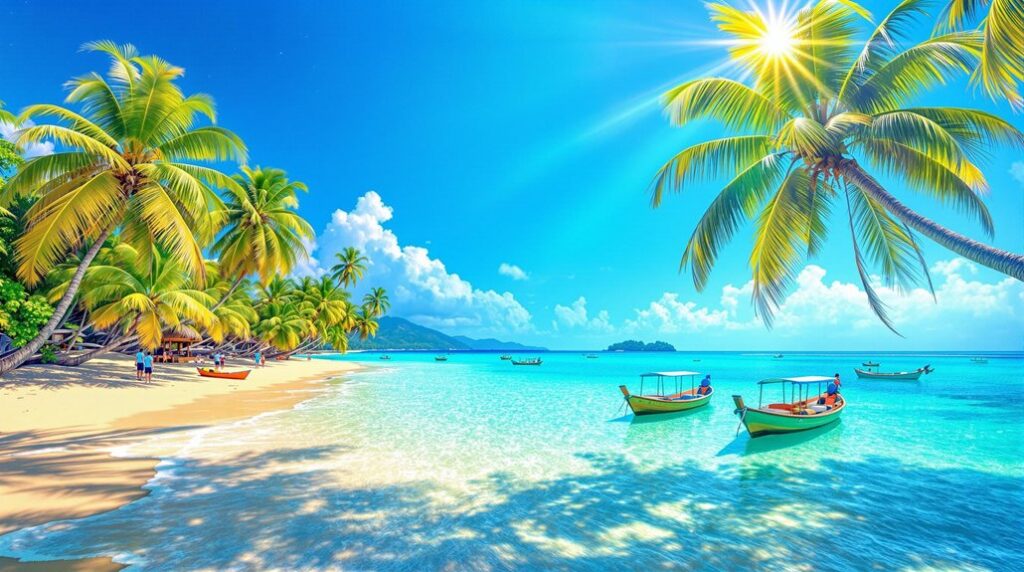
Cebu, known as the “Queen City of the South,” provides a wide range of attractions for all types of travelers. This island province skillfully combines historical sites, natural features, and modern entertainment.
History enthusiasts will appreciate Cebu’s cultural heritage. Magellan’s Cross, placed in 1521, marks when Christianity arrived in the Philippines and stands as one of the city’s most important historical sites. Fort San Pedro, a Spanish colonial military structure built in the 16th century, provides insights into Cebu’s past through its museum displays and preserved architecture.
For adventure lovers, Cebu offers exciting activities. Kawasan Falls in Badian provides stunning blue waters for swimming and canyoneering opportunities through river canyons. The clear waters of Malapascua Island allow excellent snorkeling and diving, with thresher shark sightings attracting marine enthusiasts worldwide.
Cebu City balances its historical sites with modern attractions. The city center features contemporary shopping malls, restaurants, and entertainment venues. Ayala Center Cebu and SM City Cebu provide air-conditioned respite from the tropical heat while offering shopping and dining options.
The island’s cuisine merits exploration, particularly the famous lechon (roasted pig) that Anthony Bourdain once called “the best pig ever.” Local delicacies like dried mangoes and otap (crispy oval cookies) make excellent souvenirs.
Day trips from Cebu City allow visitors to experience the island’s diverse attractions. Oslob offers whale shark encounters, while Moalboal provides sardine runs and turtle sightings. The mountainous interior features hiking trails with panoramic views of the surrounding islands and seas.
Understanding Flight Durations and Distances
When planning a Philippines trip, knowing flight times and distances helps manage expectations and plan effectively. Direct flights from major US cities to Manila vary in length:
- Los Angeles to Manila: Covers about 7,296 miles and takes 14-15 hours
- San Francisco to Manila: Spans roughly 6,978 miles, with a flight time of 14-15 hours
- New York to Manila: Covers approximately 8,510 miles, with a travel time of 17 hours
- Honolulu to Manila: The shortest route at 11-12 hours
- Seattle to Manila: Takes approximately 13.5 hours
These long Pacific flights require consideration of comfort, time, and travel preferences for a pleasant journey.
Flight durations can vary based on seasonal wind patterns, particularly the jet stream’s position and strength. Winter flights from the US to Manila might take slightly longer due to headwinds, while return flights might be shorter. These variations typically range from 30 minutes to an hour but can affect connection times for multi-leg journeys.
Aircraft type also influences flight duration. Newer planes like the Boeing 787 Dreamliner and Airbus A350 often fly more direct routes at higher altitudes, potentially reducing flight times compared to older aircraft models.
To manage the long flight comfortably, consider requesting special meals in advance, bringing an eye mask, noise-canceling headphones, and compression socks. Stay hydrated throughout the flight, and move around the cabin periodically to maintain circulation and reduce stiffness.
Exploring Connecting Flight Options
Considering connecting flights when planning your Philippines trip can provide flexibility and cost savings.
With over 46 airlines available, you can choose from various routes and experiences. Popular airlines for indirect routes include:
- East Asian carriers: Asiana Airlines, Korean Air, China Airlines, Cathay Pacific, EVA Air, and Japan Airlines
- Southeast Asian carriers: Singapore Airlines
- Middle Eastern carriers: Emirates and Qatar Airways
Common layover cities include:
- East Asia: Singapore, Hong Kong, Taipei, Seoul (Incheon), and Tokyo (Narita and Haneda)
- Mainland China: Guangzhou, Shanghai, and Beijing
- Middle East: Dubai
Flight durations for indirect routes increase due to layovers:
- Los Angeles to Manila with a Hong Kong layover: Approximately 17.75 hours
- San Francisco to Manila with layovers: Between 18-20 hours
- New York to Manila with a Tokyo layover: Can exceed 22 hours
- Chicago to Manila with various layovers: Between 19-22 hours
Total travel time depends on layover duration, connecting city location, number of stops, and airline scheduling.
Some travelers prefer connecting flights despite the longer total travel time. Breaking up a long journey allows stretching, proper meals outside the aircraft, and even short excursions during extended layovers. Several airports offer free city tours for passengers with connections of 6+ hours, such as Singapore Changi’s Heritage Tour and Incheon’s Seoul City Tour.
When booking connecting flights, consider minimum connection times. International connections typically require at least 1-2 hours, with more time needed at larger airports or when changing terminals. Booking all flight segments on a single ticket provides protection if delays cause missed connections.
The baggage policies for connecting flights vary by airline combination. When flying with partner airlines or within an alliance (Star Alliance, OneWorld, or SkyTeam), baggage typically transfers automatically. However, separate tickets might require collecting and rechecking bags, potentially necessitating entry through immigration and customs during layovers.
Pricing and Booking Strategies
Smart booking strategies can save money on your Philippines trip.
- Early flight booking often results in lower prices. September and October typically offer cheaper rates ranging from $934 to $1,047, while February also provides good deals.
- June and December tend to be expensive, with tickets averaging $1,542 and $1,833 respectively.
- Use tools like Skyscanner, Kayak, Google Flights, or Booking.com to create price alerts that notify you about changes without constant checking. Other helpful resources include Trip.com, FlightConnections, Travelocity, and ASAP Tickets.
The booking window matters significantly. For US to Philippines flights, prices often reach their lowest point 3-6 months before departure. Last-minute deals occasionally appear but remain unpredictable and risky for specific travel dates.
Consider booking flights departing mid-week rather than weekends. Tuesday and Wednesday departures typically cost less than Friday through Sunday flights. Similarly, overnight flights (red-eyes) often have lower prices than daytime departures.
Fare comparison should include baggage fees and seat selection costs, as some budget-oriented fares exclude these services. Calculate the total expense rather than just the base fare when comparing options from different airlines.
Loyalty programs provide additional value for frequent travelers. Both United Airlines (MileagePlus) and Philippine Airlines (Mabuhay Miles) offer programs that earn points usable for future flights, upgrades, or partner services. Credit cards affiliated with these programs sometimes offer substantial sign-up bonuses equivalent to a free flight.
Travel Protection for Your Philippines Adventure
A recent Philippines trip demonstrated the practical value of travel medical insurance. This coverage created peace of mind while exploring Palawan’s beaches and navigating Manila’s streets. When an unexpected flight delay occurred in San Francisco, the travel insurance covered additional accommodation costs through trip delay benefits.
SafetyWing’s Nomad Insurance Essential plan starts at $56.28 for 4 weeks and includes worldwide coverage for unexpected accidents and illnesses while traveling. The plan provides medical treatment, hospitalization, and evacuation to better-equipped facilities when needed.
The policy also includes protection for trip disruptions like delays, local unrest, or lost luggage. With a $250,000 overall coverage limit, SafetyWing offers valuable security for travelers abroad.
For those seeking more comprehensive protection, add-on options include coverage for adventure sports and electronics theft. The Essential plan provides basic health needs with travel-specific benefits at an affordable price point.
When traveling to the Philippines, consider securing medical travel insurance to protect against unexpected health issues and travel disruptions for a worry-free adventure.
Travel with Peace of Mind
Exploring the Philippines or other global destinations? Unexpected medical emergencies or trip disruptions can happen. SafetyWing offers flexible insurance options tailored for travelers and remote workers, including:
- Nomad Insurance Essential: Covers accidents, illnesses, and travel mishaps like delays or lost luggage.
- Nomad Insurance Complete: Adds routine care, mental health support, and maternity coverage.
- Remote Health: Comprehensive plans for long-term expats or digital nomads.
Note: Always review policy details to match your travel needs.
Best Times to Travel
Visit between October and February during peak travel season when warm, dry weather creates ideal conditions for sightseeing and outdoor activities. September also counts as a high season month. You can attend lively festivals like Sinulog and Ati-Atihan during this period. Book accommodations early since many travelers visit during this time.
During a December Philippines trip, consuming questionable street food in Manila caused two days of illness. SafetyWing insurance coverage helped tremendously, paying for doctor visits, medications, and follow-up appointments. Finding an English-speaking doctor through their network proved easy. The claims process worked efficiently; uploading receipts through their app resulted in reimbursement within a week. For extended trips, consider their coverage options.
May and November serve as shoulder seasons, offering pleasant weather, smaller crowds, and potentially better flight and accommodation prices.
For budget travel, consider April-July or June-October. During these months, you can enjoy:
- Lower Prices: Travel and accommodation cost less
- Fewer Tourists: Experience more personal, relaxed visits
- Special Events: Attend the Kadayawan sa Davao festival held during this period
Note that the low season coincides with rainy weather, bringing possible tropical storms and cyclones that might affect travel plans.
Weather patterns vary significantly across the Philippines due to the country’s geography. While Manila and central regions experience predictable wet and dry seasons, areas like eastern Luzon, Samar, and eastern Mindanao have reversed patterns, with rainfall during the winter months. Research your specific destinations’ climate patterns when planning.
Regional festivals provide unique cultural experiences throughout the year. The Panagbenga Flower Festival in Baguio (February), MassKara Festival in Bacolod (October), and Dinagyang in Iloilo (January) offer vibrant celebrations with parades, performances, and local cuisine. Scheduling trips around these events provides authentic cultural immersion opportunities.
Temperature variations between regions can influence travel timing. Baguio and the Cordillera mountains maintain cool climates year-round, providing respite from heat during summer months. Coastal areas experience more consistent temperatures but higher humidity. Mountain regions can become quite cold in December and January, requiring warmer clothing.
Domestic Travel Within the Philippines
For exploring the diverse Philippines islands, domestic flights provide the most efficient transportation option. Several airlines operate extensive domestic networks, including Cebu Pacific, Philippine Airlines, and AirAsia Philippines.
These airlines connect major tourist destinations with frequent, affordable flights. From Manila, you can easily reach Cebu for its rich cultural heritage and historical sites like Magellan’s Cross, Davao for natural attractions and outdoor adventures, and smaller destinations like Tacloban, Iloilo, and Laoag. Philippine Airlines alone serves numerous domestic routes from Manila to cities throughout the archipelago.
Direct flights make island-hopping practical and time-efficient. For instance, flights from Manila to Cebu take approximately 1 hour and 15 minutes, while Manila to Davao flights last about 1 hour and 40 minutes. These short flight times maximize your vacation time compared to sea travel alternatives.
Most domestic airports feature modern facilities with restaurants, shops, and lounges. Major hubs like Manila (MNL), Cebu (CEB), and Davao (DVO) offer international standard amenities, while smaller regional airports provide basic but efficient services.
Beyond air travel, the Philippines offers various transportation options. Ferries connect many islands, ranging from large, comfortable vessels between major ports to smaller pump boats serving shorter routes. Companies like 2GO Travel and FastCat operate modern ships with options from basic seating to private cabins for overnight journeys.
Land transportation includes extensive bus networks covering major islands, particularly Luzon, Cebu, and Mindanao. Bus companies like Victory Liner and Philtranco provide air-conditioned coaches between cities. For shorter distances, jeepneys (colorfully decorated vehicles) serve as public transportation in cities and between nearby towns.
For flexible exploration, car rentals with drivers provide comfortable transportation without navigation concerns. This option costs more than public transportation but offers convenience and local knowledge. Many travelers prefer this for day trips from major cities.
The Philippine National Railways (PNR) offers limited train service on Luzon, primarily serving commuter routes around Manila. While not comprehensive for tourism purposes, the train provides an authentic local experience for those interested.
Transportation apps like Grab operate in major cities, offering convenient ride-hailing services similar to Uber. These services provide reliable transportation with predetermined pricing, avoiding potential issues with traditional taxis.
Frequently Asked Questions
Are There Any Visa Requirements for US Travelers to the Philippines?
As a U.S. traveler, you don’t need a visa for trips to the Philippines if your stay is under 30 days. Just make sure your passport is valid, have travel insurance, and fill out any required declarations. This allows you to enjoy your visit without dealing with complex paperwork.
For stays beyond 30 days, you can apply for a visa extension after arrival through the Bureau of Immigration offices throughout the Philippines. These extensions can typically add 29-59 days to your stay for a fee. Multiple extensions are possible up to a maximum stay of 36 months.
Your passport must remain valid for at least six months beyond your planned departure date. Immigration officials strictly enforce this requirement, and airlines may deny boarding if your passport expires too soon after your scheduled return.
How Can Travelers Manage Jet Lag After Long Flights?
To handle jet lag, focus on adjusting your sleep schedule. Try to align your sleep with the new time zone and skip naps to help your body adapt. Staying hydrated is crucial, so drink plenty of water and avoid alcohol, which can dehydrate you. Engage in local activities and spend time outside to soak up sunlight, which can help reset your internal clock.
Light exposure plays a significant role in adjusting your body clock. Seek morning sunlight after eastward travel (such as US to Philippines) and evening light after westward travel. The Philippines’ abundant sunshine makes this strategy particularly effective.
Consider melatonin supplements to help regulate sleep patterns during adjustment. Short-acting melatonin taken before bedtime in the new time zone can help signal your body that it’s time to sleep. Consult with a healthcare provider before using supplements.
Physical activity helps reset your circadian rhythm. Light exercise like walking tours of your destination combats fatigue while providing cultural experiences. Swimming in the ocean or hotel pool similarly helps adjust to the new time zone while enjoying your surroundings.
What Are the Health and Safety Guidelines for Travelers to the Philippines?
To travel safely to the Philippines, ensure you have the necessary vaccinations and health insurance. It’s important to stay informed about which vaccinations are needed to prevent illnesses. Drink only clean, safe water to avoid getting sick, and use bug spray or wear protective clothing to keep insects away. Double-check that any medications you bring are legal in the Philippines. Be aware of the local safety conditions to ensure a smooth trip.
The CDC recommends routine vaccines plus hepatitis A and B, typhoid, and Japanese encephalitis for most travelers. Consider rabies vaccination if planning activities with potential animal exposure. Dengue fever, while not preventable through vaccination, requires precautions against mosquito bites, particularly during daytime hours.
Tap water safety varies throughout the Philippines. Stick to bottled or purified water, even for brushing teeth in most areas. Ice from restaurants in major tourist areas typically uses purified water, but confirm this when unsure.
Food safety practices help prevent travel illnesses. Choose freshly cooked hot foods, avoid raw vegetables unless properly cleaned with purified water, and be cautious with street food, selecting vendors with high customer turnover and proper handling practices.
Are There Any Travel Restrictions Due to COVID-19 for the Philippines?
You can travel freely in the Philippines as most COVID-19 restrictions have been removed. You don’t need to show proof of vaccination or undergo testing. However, it’s important to complete the eTravel registration and keep an eye on any new COVID guidelines to ensure a hassle-free trip.
The eTravel registration system replaced the One Health Pass in 2023, simplifying arrival procedures. This digital platform collects arrival information and can be completed up to 72 hours before arrival. The system generates a QR code needed during immigration processing.
While formal restrictions have eased, some establishments maintain their own health protocols. Major shopping malls, hotels, and tourist attractions might continue temperature checks or hand sanitization requirements. Carrying a face mask remains advisable for areas where they might still be required, such as healthcare facilities.
Healthcare facilities in major tourist areas maintain good standards, but remote locations offer limited services. Travel insurance covering COVID-19 treatment provides important protection despite relaxed entry requirements.
What Upcoming Route Expansions Are Planned?
Philippine Airlines has announced plans to introduce new nonstop flights to Chicago, Houston, and Las Vegas in 2025, which will provide even more direct flight options from these US cities to the Philippines.
These expansion plans form part of PAL’s fleet modernization and route development strategy. The airline continues adding modern aircraft like the Airbus A350 and Boeing 777-300ER that can handle ultra-long-haul routes efficiently.
United Airlines might expand their Philippines service following the success of their San Francisco-Manila route. Industry analysts suggest potential new routes from their Chicago or Houston hubs, though no official announcements have confirmed these possibilities.
Lower-cost carriers like Cebu Pacific continue focusing on regional Asian routes rather than long-haul US services. Their strategy emphasizes connections through Asian hubs like Seoul, where passengers can transfer to transpacific flights.
The Manila International Airport Authority continues improving Ninoy Aquino International Airport facilities to handle increased international traffic. Terminal renovations and technology upgrades aim to improve passenger experiences and increase capacity for additional flights from the US and other international destinations.
Affiliate Disclosure: Festive Pinoy may earn a commission (at no extra cost to you) if you book flights, hotels, or services through our affiliate links. We only recommend trusted providers to enhance your Philippines trip. Thank you for supporting our site!

